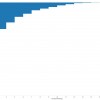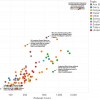Twitter have, for now, suspended our API access. Don’t panic – this is normal for Twitter applications when they reach the popularity level of ScraperWiki. It can take a couple of weeks to sort out – here’s an example thread of TraffUp going through it a while ago. For that reason, I personally apologise to our customers, […]
Where do tweets come from?
In our Twitter search tool, we provide the location of tweets via the latitude and longitude data Twitter offers. If you want to know about where the user was who created a particular tweet, it’s unfortunate then that most Twitter users (including me) don’t enable this feature. What you usually find are rare sightings of […]
What’s Twitter time zone data good for?
The Twitter friends tool has just been improved to retrieve the time zone of users. This is actually more useful than it first might sound. If you’ve looked at Twitter profiles before, you’ve probably noticed that users can, and sometimes do, enter anything they like as their location. Looking at @ScraperWiki‘s followers, we can see […]

Getting all the hash tags, user mentions…
We’ve rolled out a change so you get more data when you use the Twitter search tool! We’ve changed four columns. They used to all just randomly return one thing. Now they return all the things, separated by a space. The columns are: hashtags now returns all of them with the hashes, e.g. #opendata #opendevelopment user_mention has […]
Connecting QlikView to ScraperWiki with OData
This is a guest post by Nuno Faustino who shows how to connect QlikView to ScraperWiki using our new Odata connector. The first step is to collect some data using the ScraperWiki Platform, the demonstration here uses the our new US Stock Market data tool but could equally well have used the Twitter Follower or Twitter […]

Hiding invisible text in Table Xtract
As part of the my London Underground visualisation project I wanted to get data out of a table on Wikipedia, you can see it below. It contains data on every London Underground station including things like the name of the station, the opening date, which zone it is in, how many passengers travel through it […]

Favorite Tweets!
How often was each Tweet favorited? Now you can tell, with a new column we’ve just added to our Twitter search tool – thanks to ScraperWiki user Alden Golab for suggesting this. You can sort by that column to find the most liked Tweet on a subject. For example, ScraperWiki’s right now is about our London Underground visualization. More […]
Our new US stock market tool
In a recent blog post, Ian talked about getting stock market data into Tableau using our Code in a Browser tool. We thought this was so useful that we’ve wrapped this up into an easy-to-use tool. Now you can get stock data by pressing a button and choosing the stocks you’re interested in, no code […]
Try out the Tableau and QlikView connector
In March, we launched an OData tool. If you use Tableau or QlikView, it lets you easily get and refresh data from ScraperWiki. From today, the OData tool is now available on our new 30 day trial accounts. Which means anyone can try it out for free! Instructions here (particularly for Tableau).

Verified Twitter users
We’ve added a “verified accounts” column to our Twitter friends tool – thanks to ScraperWiki user Delfin Paris for suggesting this. The 1 means it is a Twitter verified account, 0 means it isn’t. You can sort by that column to find all the most notable accounts that are following someone. For example, ScraperWiki has 44 followers who […]
